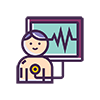How Does the Defibrillator Work?
To many, a defibrillator is a rather frightening device; a machine that delivers an often life-saving shock.
But how does this same shock, which ordinarily would harm a healthy person, actually work?
Read on to find out how a defibrillator achieves this.
Heartbeat and Rhythm
To know how does the defibrillator work, we must first understand how the heartbeat works.
The heart is a muscle that works as a pump to move blood around the body, delivering oxygen to organs. What we know of as a heartbeat is when the heart contracts and relaxes, pushing blood through itself in the process.
A healthy heart beats at a regular rhythm and tempo, allowing it to pump blood efficiently.
Electrical Signals
 The normal heart rhythm is maintained by electrical signals in the heart. These electrical signals originate in an area of the heart called the Sinoatrial Node (SA Node). The SA Node acts as the metronome, or natural pacemaker, of the heart.
The normal heart rhythm is maintained by electrical signals in the heart. These electrical signals originate in an area of the heart called the Sinoatrial Node (SA Node). The SA Node acts as the metronome, or natural pacemaker, of the heart.
Some heart conditions cause the heart to beat outside of its normal, healthy rhythm, causing what is known as an arrhythmia.
While some arrhythmias are not immediately life-threatening, others can quickly compromise the heart’s ability to effectively pump blood. In these situations, a defibrillator becomes useful.
A Quick Reset
An example of a life-threatening arrhythmia is Ventricular Fibrillation (VF). VF causes the lower chambers of the heart to quiver erratically, preventing blood from being effectively passed through them. This leads to a Sudden Cardiac Arrest (SCA).
To fix this, a defibrillator would be used to “reset” the arrhythmia, allowing the SA Node to deliver a proper rhythm.
A defibrillator achieves this by sending a shock of current to the patient’s heart. The shock is strong enough to overcome the arrhythmia, effectively resetting the electrical system of the heart.
How Defibrillators Are Used by Professionals
 A manual-use defibrillator is a device that outputs a small burst of current through two electrodes, normally in the form of hand-held paddles. To use it, a medical professional will:
A manual-use defibrillator is a device that outputs a small burst of current through two electrodes, normally in the form of hand-held paddles. To use it, a medical professional will:
- Apply conductive gel on the patient’s chest to increase contact with the paddles and minimize burn damage. (Some paddles come pre-gelled.)
- Set the defibrillator to deliver a certain amount of electrical energy to the patient, normally measured in Joules.
- Position the paddles, one on each side of the heart. The precise position can vary between patients.
- Apply firm pressure on the paddles against the chest, ensuring the shock is delivered as effectively as possible.
Note that the defibrillator is unable to deliver the electrical shock until the medical professional operating it manually triggers it.
Types of Defibrillators
Not all defibrillators are intended for manual use. Other types of defibrillators include:
- Implantable Cardioverter-Defibrillator (ICD) – A device that delivers defibrillation therapy from within the body. It’s used as a preventative treatment, constantly monitoring the heart and automatically delivering defibrillation upon detecting an arrhythmia.
- Automatic External Defibrillator (AED) – Similar to a manual defibrillator, AEDs are normally designed for use by untrained people. They can direct the user and diagnose arrhythmia as well as administer defibrillation.
Unlike manual defibrillators and AEDs, an ICD is normally attached directly to the heart. A small box is implanted in the chest, usually below the collarbone, from which a wire connects through the veins to the inside of the heart.
AEDs also differ from manual defibrillators in that they are not operated using paddles. Instead, the electrodes operate through adhesive patches applied to the chest. The directions for use of the AED will instruct the user on their application.
A Common Misconception
One of the most common misconceptions about defibrillators is that they can restart a heart that has completely stopped. This is not the case.
A defibrillator is unable to restart a heart that has stopped. Its purpose is to reset the heartbeat to its natural rhythm. In reality, shocking a patient whose heart has stopped can cause greater harm.
The Wrap Up
The general method of defibrillation has remained much the same over the years. It continues to be the only effective method of treatment for some conditions. Yet even if defibrillation itself still seems scary, the devices used to deliver it have become more efficient and subtle.
So subtle that you might pass somebody on the street with a defibrillator beneath their clothes without even realizing it.
